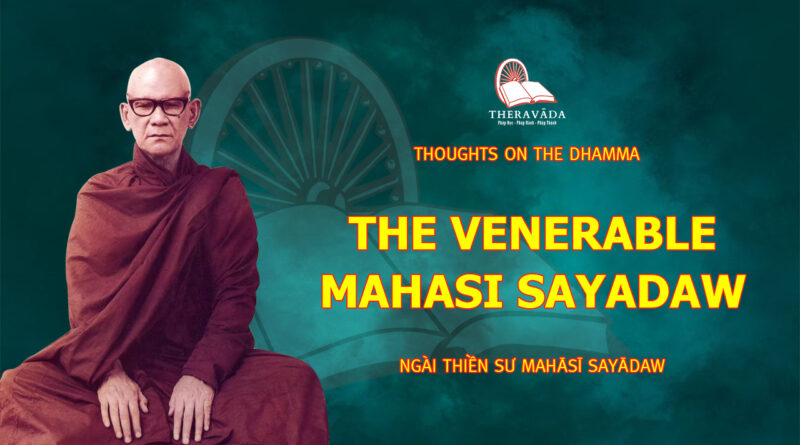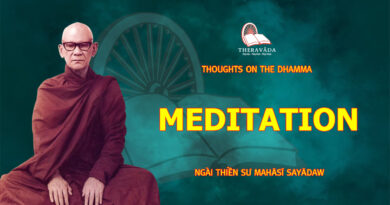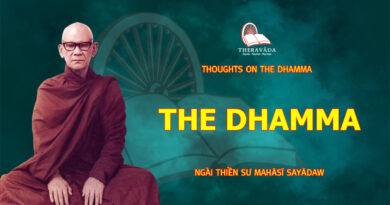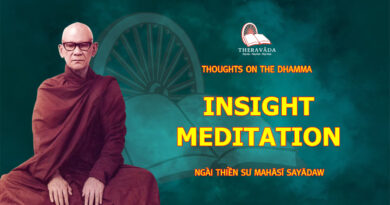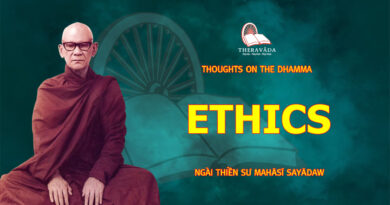1. The Venerable Mahasi Sayadaw
The Venerable U Sobhana Mahathera, better known as Mahasi Sayadaw, was born on 29 July 1904 to the peasant proprietors, U Kan Htaw and Daw Shwe Ok at Seikkhun Village, which is about seven miles to the west of the town of Shwebo in Upper Burma, once the capital of the founder of the last Burmese dynasty.
At the age of six he began his studies at a monastic school in his village, and at the age of twelve he was ordained a samanera (novice), receiving the name of Sobhana. On reaching the age of twenty, he was ordained a bhikkhu on 26 November 1923. He passed the Government Pali Examinations in all the three classes (lower, middle, and highest) in the following three successive years.
In the fourth year of his bhikkhu ordination, he proceeded to Mandalay, noted for its pre-eminence in Buddhist studies, where he continued his further education under various monks of high scholastic fame. In the fifth year he went to Moulmein where he took up the work of teaching the Buddhist scriptures at a monastery known as Taung-waing-galay Taik Kyaung.
In the eighth year after his bhikkhu ordination, he and another monk left Moulmein equipped with the bare necessities of a bhikkhu (i.e., almsbowl, a set of three robes, etc.), and went in search of a clear and effective method in the practice of meditation. At Thaton he met the well-known Meditation Teacher, the Venerable U Narada, who is also known as Mingun Jetawun Sayadaw the First. He then placed himself under the guidance of the Sayadaw and at once proceeded with an intensive course of meditation.
He had progressed so well in his practice that he was able to teach the method effectively to his first three disciples in Seikkhun while he was on a visit there in 1938. These three lay disciples, too, made remarkable progress. Inspired by the example of these three, gradually as many as fifty villagers joined the courses of intensive practice.
The Venerable Mahasi could not stay with the Venerable Mingun Sayadaw as long as he wanted as he was urgently asked to return to the Moulmein monastery. Its aged head monk was gravely ill and passed away not long after the Venerable Mahasi’s return. The Venerable Mahasi was then asked to take charge of the monastery and to resume teaching the resident monks. During this time he sat for the Pali Lectureship Examination on its first introduction by the Government of Burma. Passing this examination on the first attempt, in 1941 he was awarded the title of Sasanadhaja Sri Pavara Dhammacariya.
On the event of the Japanese invasion, the authorities gave an evacuation order to those living near Moulmein at the Taung-waing-galay Monastery and its neighborhood. These places were close to an airfield and hence exposed to air attacks. For the Sayadaw this was a welcome opportunity to return to his native Seikkhun and to devote himself wholeheartedly to his own practice of Vipassana meditation and to the teaching of it to others.
He took residence at a monastery known as Maha-Si-Kyaung, which was thus called because a drum (Burmese si) of an unusually large (maha) size was housed there. From that monastery, the Sayadaw’s popular name, Mahasi Sayadaw, is derived.
It was during this period, in 1945, that the Sayadaw wrote his great work, Manual of Vipassana Meditation, a comprehensive and authoritative treatise expounding both the doctrinal and the practical aspects of the Satipatthana method of meditation. This work of two volumes, comprising 858 pages in print, was written by him in just seven months, while the neighboring town of Shwebo was at times subjected to almost daily air attacks. So far, only one chapter of this work, the fifth, has been translated into English and is published under the title Practical Insight Meditation: Basic and Progressive Stages (Buddhist Publication Society).
It did not take long before the reputation of Mahasi Sayadaw as an able teacher of insight meditation (Vipassana) had spread throughout the Shwebo-Sagaing region and attracted the attention of a prominent and very devout Buddhist laymen, Sir U Thwin, who was regarded as Burma’s Elder Statesman. It was his wish to promote the inner strength of Buddhism in Burma by setting up a meditation center to be guided by a meditation teacher of proven virtue and ability. After meeting Mahasi Sayadaw and listening to a discourse given by him and to the meditation instructions given to nuns in Sagaing, Sir U Thwin was in no doubt that he had found the ideal person he was looking for.
In 1947 the Buddha Sasana Nuggaha Organization[2] was founded in Rangoon with Sir U Thwin as its first President and with its object the furthering of the study (pariyatti) and practice (patipatti) of Buddhism. In 1948 Sir U Thwin donated five acres of land at Kokine, Rangoon, to the organization for the erection of a meditation center. It is on this site that the present Thathana (or Sasana) Yeiktha, i.e., “Buddhist Retreat,” is situated, which now, however, covers an area of twenty acres, with a large number of buildings.
In 1949, the then Prime Minister of Burma, U Nu, and Sir U Thwin requested that the Venerable Mahasi Sayadaw come to Rangoon and give training in meditational practice. On 4 December 1949, the Sayadaw introduced the first group of 25 meditators into the methodical practice of Vipassana meditation. Within a few years of the Sayadaw’s arrival in Rangoon, similar meditation centers sprang up all over Burma, until they numbered over one hundred. In neighboring Theravada countries like Thailand and Sri Lanka such centers were also established in which the same method was taught and practiced. According to a 1972 census, the total number of meditators trained at all these centers (both in Burma and abroad) had passed the figure of seven hundred thousands. In the East and in several Western countries as well, Vipassana courses continue to be conducted.
At the historic Sixth Buddhist Council (Chatta Sangayana) held at Rangoon for two years, culminating in the year 2500 Buddhist Era (1956), the Venerable Mahasi Sayadaw had an important role. He was one of the Final Editors of the canonical texts, which were recited and thereby approved, in the sessions of the Council. Further, he was the Questioner (Pucchaka) — that is, he had to ask the questions concerning the respective canonical texts that were to be recited. They were then answered by an erudite monk with a phenomenal power of memory, by the name of Venerable Vicittasarabhivamsa. To appreciate fully the importance of these roles, it may be mentioned that at the First Council held one hundred days after the passing away of the Buddha, it was the Venerable Maha Kassapa who put forth those introductory questions which were then answered by the venerable Upali and the Venerable Ananda .
After the recital of the canonical scriptures, the Tipitaka, had been completed at the Sixth Council, it was decided to continue with a rehearsal of the ancient commentaries and subcommentaries, preceded by critical editing and scrutiny. In that large task, too, the Sayadaw took prominent part.
In the midst of all of these tasks, he was also a prolific and scholarly writer. He authored more than 70 writings and translations, mostly in Burmese, with a few in the Pali language. One of these deserves to be singled out: his Burmese translation of the Commentary to the Visuddhi Magga (Visuddhimagga Maha-Tika), which, in two large volumes of the Pali original, is even more voluminous than the work commented upon, and presents many difficulties, linguistically and in its contents. In 1957 Mahasi Sayadaw was awarded the title of Agga-Maha-Pandita.
Yet even all of this did not exhaust the Sayadaw’s remarkable capacity for work in the cause of the Buddha-Dhamma. He undertook several travels abroad. The first two of his tours were in preparation for the Sixth Council, but were likewise used for preaching and teaching:
Thailand, Cambodia, and Vietnam (1952); India and Sri Lanka (1953, 1959); Japan (1957); Indonesia (1959); America, Hawaii, England, Continental Europe (1979); England, Sri Lanka, Singapore, Malaysia, Thailand (1980); Nepal, India (1981).
In the midst of all these manifold and strenuous activities, he never neglected his own meditative life which had enabled him to give wise guidance to those instructed by him. His outstanding vigor of body and mind and his deep dedication to the Dhamma sustained him through a life of 78 years.
On 14 August 1982, the Venerable Mahasi Sayadaw succumbed to a sudden and severe heart attack which he had suffered the night before. Yet on the evening of the 13th, he had still given an introductory explanation to a group of new meditators.
The Venerable Mahasi Sayadaw was one of the very rare personalities in whom there was a balanced and high development of both profound erudition linked with a keen intellect, and deep and advanced meditative experience. He was also able to teach effectively both Buddhist thought and Buddhist practice.
His long career of teaching through the spoken and printed word had a beneficial impact on many hundreds of thousands in the East and in the West. His personal stature and his life’s work rank him among the great figures of contemporary Buddhism.

